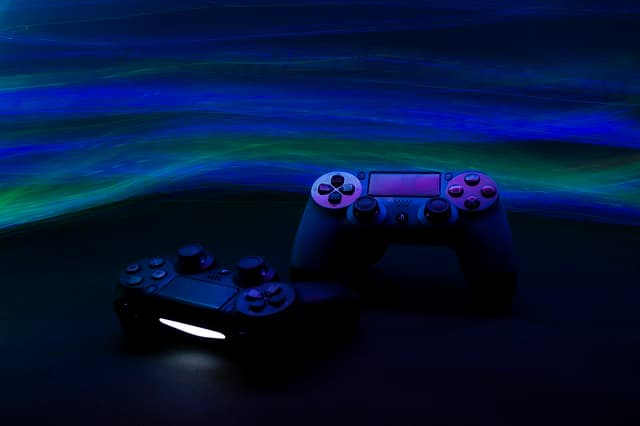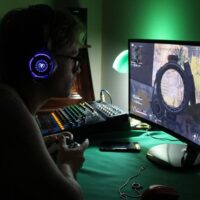
Want to know how video games are created? This article discusses the video game development process, and in particular “pipeline,” an industry term for the process of creating a video game from scratch.
What is a game development pipeline?
A game development pipeline is the process of creating a video game from concept to completion. Similar to a production line, a game development pipeline helps organize the flow of work so that everyone knows what needs to be implemented and when. The pipeline also helps manage the game development schedule and budget, reducing inefficiencies and bottlenecks.
While pipelines vary between projects and studios, the process is pretty similar whether you’re working on an indie or mobile game.
A game is constantly evolving, and things that seemed great in theory may not work so well in reality. Consequently, the pipeline is not necessarily a linear process. Work needs to be directed toward creative approval and can often come back for refinement. Conveyors must be flexible enough to accommodate revisions and course changes.
3 stages of game development
Video game development is usually divided into 3 phases: pre-production, production, and post-production.
- Pre-production
This is where every project begins. Essentially, pre-production defines what the game is about, why you want to make it, and what it takes to make it. You may have a great idea for a type of game, a story you want to bring to life, or you may want to create one that uses a certain type of technology (like VR, a new controller or console). In the pre-production phase, you should have answers to questions such as: What is the game about?
Who is our target audience/users/audience?
Are there analogs in this market? What is the competition?
What platform will the project be created on?
How will it be monetized? Will it be sold on the platform or will it be sold for free with in-game purchases?
How long will it take to develop?
What staff and resources will it require?
What is the estimated budget?
This phase can take anywhere from a week to a year, depending on the type of project, available resources and finances, and usually takes up to 20% of the total production time.
At this point, the team is fairly small. It could be a producer, a programmer, a concept artist (or, if you’re working alone, you’ll be doing most of it!).
The video game producer handles the business aspect of the project, especially the financial aspect. They manage the budget and develop marketing strategies to sell the product.
Concept – The artist sets the tone for the project early on through development and art sketches. These early visuals help shape the language of the game, giving everyone working on the project a visual guide to the overall look.
The information gathered during this pre-production phase forms the basis of the game design document. The Game Design Document (GDD) is essentially the north star of the game. It is a living document that helps everyone understand and embrace the broader vision of the project.
The GDD includes:
- Idea or concept
- Genre Plot and characters
- Basic game mechanics
- Gameplay
- Level and world design
- Art and/or sketches
- Monetization strategy
As a living document, GDD is constantly being updated and improved during production. This can be due to technical or financial constraints, or simply the realization that some things don’t look, work, or work as well as you originally hoped.
Many people, especially small developers, like to use more agile development methods that are less about process and documentation and more about simple builds. Larger studios, however, prefer a different approach. EA, Microsoft, Sony, Ubisoft, and other big game companies are heavily process-oriented and require complex documentation. It’s a big part of how they succeed time and time again.
GDD keeps you organized, helps you identify potential risks, and lets you see ahead of time who you may have to hire/outsource to bring your project to life. Your game idea may seem pretty simple, but once you lay it out in a GDD, you’ll soon realize just how big and resource-intensive your project is. Projects without a plan are more likely to run on time and budget.
Another reason to have a GDD is to help promote and fund your game. Potential investors will want to see a solid plan before investing. Finally, a GDD will help you promote your product once it is ready for release.
Prototyping
A video game prototype is a raw test that tests functionality, user experience, gameplay, mechanics, and artwork. Prototyping occurs in the pre-production phase to see if a game idea will work and is worth pursuing. Many ideas don’t make it through this stage.
The team often starts with paper drafts to test theories and work through the many nuances of a game or series of systems quickly, easily, and economically.
While ideas, psychology, theories, and other deep thinking metaphors are important, you can only construct so far in your mind or on paper. Most game ideas need to be touched, felt, played with, and tested much sooner than later.
The goal is to get the prototype up and running as soon as possible to see if your ideas really work and if the game is as exciting as you hoped. Prototyping can also reveal unexpected problems that could potentially change the entire course of your project. It’s important to have others test your prototype, because things that are obvious to you may not be to others.
Game Design
Filler assets are used to save time and money. These low-quality resources replace things like weapons and props early in testing, and if they are approved, they will be replaced later with final, high-quality versions.
Filler resources can be bought or found for free online in game development software. Usually these are fairly simple forms, but they can also be a little more advanced, such as this Soul: Cave resource pack from Epic Games for Unreal Engine 4.
- Production
Production is the longest phase of the pipeline. The game takes anywhere from 1 to 4 years, and that’s when the game really starts to take shape. Story is refined, resources (characters, creatures, objects, and environments) are created, game rules are established, levels and worlds are created, code is written, and more!
Almost everything in video games is a conscious decision. This includes all characters, environments, object, as well as appearance, colors, sounds, difficulty level, rules, and scoring system. However, initial ideas don’t always translate that well, so the game is constantly being tested and refined as the work progresses.
Let’s take a look at the basic stages of game production and some key video game development jobs, keeping in mind that smaller teams will have to fill multiple roles, while a larger studio will have more employees, many of whom specialize in a particular aspect of production.
According to industry veteran Troy Dunneway, creator of CG Spectrum’s Game Design Diploma, because players expect cinematic quality graphics, 75-90% of the game budget goes to design.
The main stages of production
There are several stages to the game development process.
Prototype: this is the initial testing of the game (which takes place during the pre-production stage and is detailed above). Some games may never make it past this stage. First playability: the first playability gives a much better idea of the look and feel of the game. Although it is still far from final, fills are replaced with better assets and illustrations are added. Vertical Slice: A vertical slice is a fully playable sample that can be used to present your game to studios or investors. A vertical slice, from a few minutes to half an hour, allows you to see the game firsthand. Pre-alpha: Much of the content is developed during the pre-alpha phase. Several important decisions will need to be made during this phase of game development. Content may be cut, or new elements may need to be added to improve gameplay. Alpha: The game is “complete,” which means that all major features have been added and the game is playable in its entirety from start to finish. Some elements, such as art assets, may still need to be added, but the controls and features should work properly. QA testers will make sure everything works smoothly and report bugs to the team. Beta: at this stage, all content and resources are integrated, and the team should focus on optimizing rather than adding new features or functionality. Gold master: the game is final and ready to be sent to the publishing house and released to the general public.
One of the best-selling games of all time, Minecraft has over 100 million monthly active players.
Key roles in game development
Game development roles vary depending on the size and type of studio. Here are some of the common positions you’ll find.
Project Manager.
The project manager makes sure that the game development process runs smoothly, milestones are met, risks are predicted/reduced, and team members do what they need to do. They are often the center of communication between developers, design teams, and executives. Project managers are exceptionally organized and must have excellent communication and people skills.
Game Developers / Programmers
Game programmers help develop games by turning design concepts into code to create playable games. Programmers are specialists with extensive programming experience, and have the combination of creativity, math skills, and patience to successfully translate ideas into interactive visuals and sounds. They ensure that the game runs smoothly.
There are many different aspects of programming, including:
- Creating a custom base engine for the game
- Scenario features, events, interactions
- Creating physics (e.g., differences in gravity in a game whose action takes place in space)
- Development and modification of 3D graphics renders
- Simulating artificial intelligence in enemies
- Adding sound effects, music and voice-over Implementation of game logic and mechanics
- Creating UI
- Writing code for keyboards, mice or joysticks
- Enabling players to compete or collaborate over a local network or the Internet
- Develop your own tools
- Porting code between platforms
- Implementing algorithms, solving memory and caching problems
- Bug fixing and detection
At larger studios, you’ll find specialists dedicated solely to AI game programming
Game designers
A game designer is a creative game driver, and generally a mixture of a writer and an artist, with knowledge of programming. A section of the game design pipeline involves creating compelling stories, characters, goals, rules, and objectives that encourage interaction with other characters, users, or objects. Designers may be responsible for:
- Developing the storyline, character backstory, and dialogue
- Developing gameplay, rules, and scoring system
- Determining the level of difficulty
- Building environments, protrusions, obstacles, and objects Level and world design
- Programming / scripting
- Digital editing
If you work for a larger company, these tasks may resemble individual roles, which we’ll look at next.
Level designers
A video game level designer is responsible for creating interesting and engaging levels. Their job is to keep the player focused on progressing through the game and reaching their goal or mission, while reducing the possibility of confusion.
Because games are much more complex than they used to be, larger studios often have game designers dedicated solely to level design. Level designers draw inspiration from concept art, photo guides, and GDDs to draw believable maps and create physical models of levels.
Depending on the type of game and whether it is based on real events (such as a World War II battle), they may need to learn all about a particular period of history and explore real locations to make sure the level is realistic and believable. If the game is adapted from a book or movie, they will need to read/watch the original and look for clues. If the world is entirely fictional, they’ll need to use their creativity and draw inspiration from the concept art provided.
Then, using the level editor (the software used to design levels and maps), they will create levels, stages, or missions. Their work may also include things like planning start and exit locations, determining where tunnels and hidden passages will be, places where interactions or dialogue will take place, monster appearance points, trigger points where certain actions will take place, and more.
Level designers are responsible for identifying and fixing bugs, such as players walking out of the playground or getting stuck and not being able to get out. The problem with video games is that once a game is released, it is no longer in the hands of the designer. The player can interact with worlds in unexpected ways, revealing bugs that went unnoticed during development.
Game Artists
Game artists can include concept artists , animators , 3D model developers and FX artists. This group is responsible for bringing color, movement and life to the game. While the concept artist is mostly active in the pre-production phase, when they are developing the initial look (usually in 2D), they may be involved again later in the game development process if new elements are added or the game changes course.
A 3D concept artist (who may be the same artist) will use digital sculpting software such as ZBrush, Maya, and Photoshop to create 3D props, resources, and environments. They will also add textures and details.
3D Model Developers
3D model developers create models of people, objects, props, weapons, and environments, which can then be textured and animated as needed. Model developers need to know how to collect and use high-quality reference materials, especially if they are replicating real objects (e.g. AK-47, Buzzard Attack Chopper, Eiffel Tower, etc.).
Model developers can use photos of the objects they create or drones if the object is much larger and they need an aerial view. If the game is entirely fantasy, they will need to refer to the concept art and use their imagination to come up with something new and unique.
Game Animators
Game animators add depth and realism by adding believable movement to characters, objects and environments. They will create storyboards and outline key animation scenes that fit the game’s storyline. Animators often have to do a lot of research (e.g., observing how animals behave and interact with others when working on an animal game). Motion capture data can also be used to create more realistic animations.
FX Artists
FX artists give players a more immersive and engaging experience by adding stunning effects such as explosions, smoke, fire, and fluid simulations, as well as weather phenomena such as rain, lightning, blizzards, and more. Game FX artists usually use software such as Houdini FX or Maya, but should also have experience with game engines such as Unity or Unreal Engine 4.
Audio Engineers / Sound Engineers / Composers
Sound experts develop realistic sound effects, record voice-over / dialogue between characters, and create soundtracks that set the mood for players by adding soundtrack or sound cues.
QA (quality assurance) / video game testers
Video game testers are essential in the game development process! These people test games, look for bugs, and make sure the game runs smoothly and the instructions are clear to players. They report bugs to the development team in what is sometimes called a bug list.
Additional Roles
In addition to the game development roles mentioned above, larger studios may be able to bring in a number of additional specialists, such as:
- Quest designers.
- Writers Interpreters and translators
Later in the game development process, the development team plays a more important role in helping to manage the marketing and distribution of the game.
- Post-production
Once production and release of the game is complete, the game development process continues, and some team members are moved to maintenance (fixing bugs, creating patches) or creating bonus or downloadable content (DLC). Others may move on to a sequel or the next project.
There can be a debriefing to discuss what worked and what didn’t work and to determine what could have been done better next time. All project documents, assets, and code are finalized, collected, and stored in case they are needed in the future.
Additional resources for game development
If you want to make video games, it’s important to understand the game development process.
Regardless of what part of the pipeline your role is in, knowing the goals and order of each department will help you work efficiently and reduce costly problems in the future.
You don’t need to know how to do everyone’s work, but you do need to know how your work affects their work and how to pass on useful work to the next stage of production. Understanding the process will also help you find work, since every major studio uses a video game production schedule.


